| |
|
|
|
|
|
|
 |
| |
|
|
|
|
|
|
~Term~ |
|
~Illustration~ |
|
~Description~ |
|
~Return~ |
|
|
|
|
|
|
|
| Abutment |
 |
 |
 |
An abutment is a solid mass of masonry that receives and resists the lateral
force exerted by one haunch of an arch. Although an abutment is not considered
a structural element of an arch the stability of an arch depends on the strength
of the two abutments that its haunches press against; the fixed abutments
prevent the lateral thrust produced through the voussoirs from forcing the
haunches to spread apart and cause the arch to fall into the open area that
it was intended to span. An abutment is distinguished from a pier by its
support of only one haunch of a single arch. |
|
|
|
|
|
|
|
|
 |
| Arch Ring |
 |
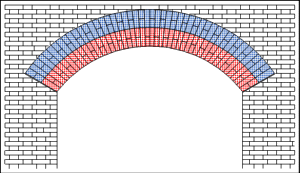 |
 |
An arch ring is a single bonded layer of voussoirs composing an arch. In
cases when an arch is composed of more than one bonded layers of voussoirs
the term is sometimes used to refer to all layers of voussoirs. Red and blue
areas in the illustration (left) may be taken as a single arch ring composed
of two concentric rings or two separate arch rings, one blue, one red. In
masonry fortifications multiple arch rings were often used to enhance the
redundant strength of bomb-proof vaulted structures such as magazines and
casemates. |
|
|
|
|
|
|
|
|
 |
| Axis of an Arch |
 |
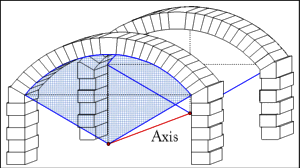 |
 |
The axis of an arch is an imaginary line running in a transverse direction
under the arch from the plane of one face of the arch to the plane of the
opposite face. It is centered according to the nature of the curve of the
intrados of the arch: for a curve that is an arc of circle the axis begins
at the center of the circle; for an ellipse the axis begins at the point
where the major and minor axes of the ellipse intersect. When the intrados
is formed by tangent circles (as is the case when the curve has more than
one center) or intersecting arcs of circles (pointed arches) the arch may
have more than one axis. |
|
|
|
|
|
|
|
|
 |
| Bed Joints |
 |
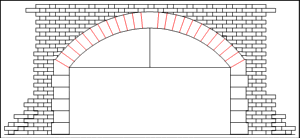 |
 |
In the general parlance of masonry construction a bed is a horizontal connection
between two tiers (courses) of stones or bricks while a joint is a vertical
plane where two stones in the same tier connect to each other. Since curved
arches are generally neither horizontal nor vertical the term bed joint is
applied to the plane along which two voussoirs of the same arch ring connect
to each other. In most cases this plane is filled with mortar to bond the
voussoirs together and is oriented normal (that is, prrpendicular) to the
axis of the arch. |
|
|
|
|
|
|
|
|
 |
| Coursing Joints |
 |
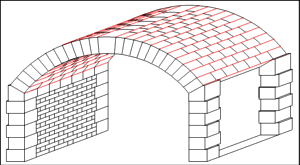 |
 |
Coursing joints in an arch are the joints between courses of voussoirs that
run through the sheeting of an arch from one face to the opposite face. These
joints are generally parallel to the axis of the arch. |
|
|
|
|
|
|
|
|
 |
| Crown |
 |
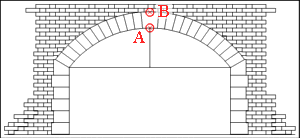 |
 |
| Various sources understand the crown of an arch differently: |
A: The Crown is synonymous with the Vertex as the highest point
of the intrados above the line of the span; |
B: The Crown is sometimes taken as the highest point of the arch
ring above the line of the span or the highest point of the extrados above
the span. |
|
|
|
|
|
|
|
|
|
 |
| Cushion Stones of the Abutment |
 |
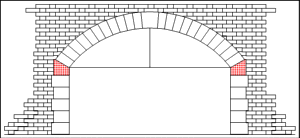 |
 |
Cushion stones of an abutment are the stones or bricks composing the uppermost
course of an abutment or pier that receive the thrust of the arch from the
springers of the arch. |
|
|
|
|
|
|
|
|
 |
| Extrados |
 |
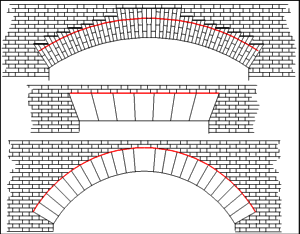 |
 |
The extrados of an arch is generally understood as the exterior convex curve
formed by the upper surface of the voussoirs of the arch ring. In flat arches
the extrados is a more or less horizontal line. For arches with extended
voussoirs shaped to join masonry courses of the spandrels at horizontal and
vertical angles the extrados is taken as the curved line formed by the upper
limits of those parts of the voussoirs that receive the lateral thrust of
other voussoirs. |
|
|
|
|
|
|
|
|
 |
| Face |
 |
 |
 |
The outer or visible surface of an arch ring is referred to as the face of
the arch. By extension the term is sometimes used to encompass the arch ring
and the visible surfaces of the abutments or piers that support an arch. |
|
|
|
|
|
|
|
|
 |
| Haunch |
 |
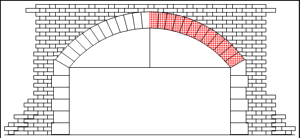 |
 |
One half of an arch ring running from the crown down to the line of the impost
or skewback. The haunch was also occasionally called the hanse or flank of
the arch. |
|
|
|
|
|
|
|
|
 |
| Heading Joints |
 |
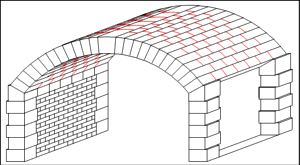 |
 |
Joints between the heads (vertical ends) of voussoirs in an arch were referred
to as heading joints. These joints were generally perpendicular to the direction
of the axis of an arch. Since the sheeting of most arches was constructed
with broken joints so that each heading joint fell near the mid-point of
a voussoir of the next lower tier of voussoirs heading joints, unlike coursing
joints, rarely formed a continuous line through the haunch of an arch from
vertex to impost. |
|
|
|
|
|
|
|
|
 |
| Impost |
 |
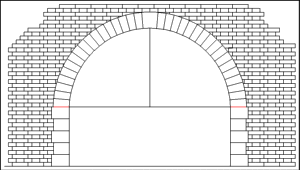 |
 |
The plane formed by the bed joint between the springers of an arch and the
cushion stones of the abutment (or pier) is called the impost of the arch.
When the imposts of an arch are sloped (oblique to the horizon) it is called
the skewback of the arch. Some period sources refer to the imposts as the
platbands of an arch. |
|
|
|
|
|
|
|
|
 |
| Intrados |
 |
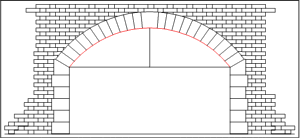 |
 |
The intrados of an arch is the line followed by the interior or lower ends
of the voussoirs that runs from one impost (or skewback) to the other
and terminates at the springing lines of the arch. |
|
|
|
|
|
|
|
|
 |
| Keystone |
 |
 |
 |
In stone arches the voussoir (arch stone) at the vertex of the arch where
the two halves of the arch connect is called the keystone. During construction
of an arch the keystone was usually the last arch stone placed in position
and keyed (finished and fixed) the arch. As a matter of ornamentation the
keystone was often given somewhat larger dimensions than other arch stones,
but as a matter of receiving pressure of the vertical load was no more or
less important to the equilibrium of the arch than any other arch stone. |
|
|
|
|
|
|
|
|
 |
| Pier |
 |
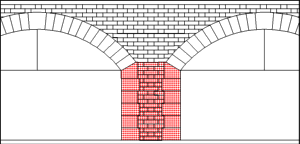 |
 |
A round or quadrilateral column that receives and supports the load transmitted
by two or more arch haunches is referred to as a pier. An abutment, by contrast,
only receives the load of one haunch of an arch. |
|
|
|
|
|
|
|
|
 |
| Rise |
 |
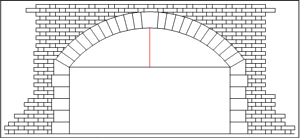 |
 |
The rise of an arch is the vertical height of the vertex of the intrados
above the plane of the springing lines. It is usually measured along a vertical
line that rises from a point that bisects the span and ascends to the vertex
of the arch. |
|
|
|
|
|
|
|
|
 |
| Sheeting |
 |
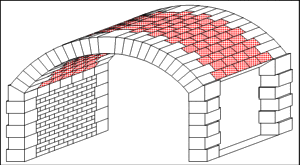 |
 |
The body of an arch falling between the two faces is referred to the sheeting
of the arch. The lower or interior side of the sheeting is referred to as
the soffit and the upper or exterior side is called the back of the arch. |
|
|
|
|
|
|
|
|
 |
| Skewback |
 |
 |
 |
When an impost of an arch is oblique to the horizon it is referred as a skewback.
As with an impost a skewback is the surface where the springers of the arch
fall onto the upper surface of the cushion stones of the abutment or pier. |
|
|
|
|
|
|
|
|
 |
| Span |
 |
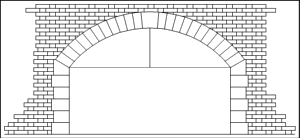 |
 |
The distance between the springing line of one haunch of an arch to the springing
line of the opposite haunch is called the span of the arch. This usually
represents the lateral dimension of the open area beneath an arch. |
|
|
|
|
|
|
|
|
 |
| Spandrel |
 |
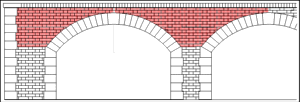 |
 |
Although not specifically part of an arch a spandrel is the area between
collateral haunches of adjacent arches that spring from the same pier. When
an arch haunch springs from an abutment the term is applied to the area above
the abutment and arch haunch. |
|
|
|
|
|
|
|
|
 |
| Springers |
 |
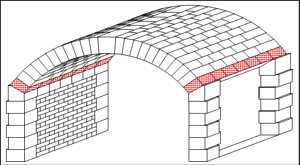 |
 |
Voussoirs composing the first course of masonry that rests on the cushion
stones of the abutment are called springers. |
|
|
|
|
|
|
|
|
 |
| Springing Line |
 |
 |
 |
A springing line runs parallel to the axis of an arch from one face to the
other along the interior edge of the joint between the springers and cushion
stones of the abutment. It is the line of demarcation where the arch springs
from the abutment or pier. |
|
|
|
|
|
|
|
|
 |
| String Course |
 |
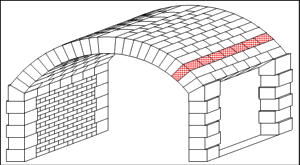 |
 |
Each course of voussoirs running from one face of an arch to the opposite
face is referred to as a string course. Voussoirs in the same string course
connect at heading joints; string courses connect to each other along coursing
joints. |
|
|
|
|
|
|
|
|
 |
| Vault |
 |
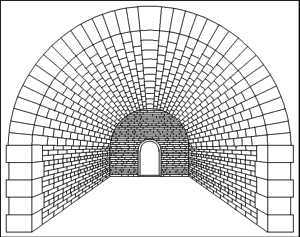 |
 |
A vault is any arch extended in the direction of its axis for the purpose
of spanning and enclosing an open space. In most cases the arch forms the
ceiling of an interior space within a building while the abutments or piers
holding the arch in place serve as side walls or transverse boundaries. |
|
|
|
|
|
|
|
|
 |
| Vertex |
 |
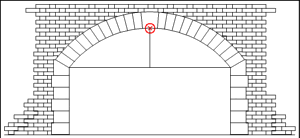 |
 |
The highest point of the intrados of an arch above the line of the span is
referred to as the vertex of the arch. This point is also generally, but
not always, called the crown of the arch. |
|
|
|
|
|
|
|
|
 |
| Voussoir
Arch Stone |
 |
 |
 |
Truncated wedge shaped stones or bricks that are stacked to form the arch
ring are called voussoirs or arch stones. |
|
|
|
|
|
|
|
|
 |
|
|
|
|
|
|
|